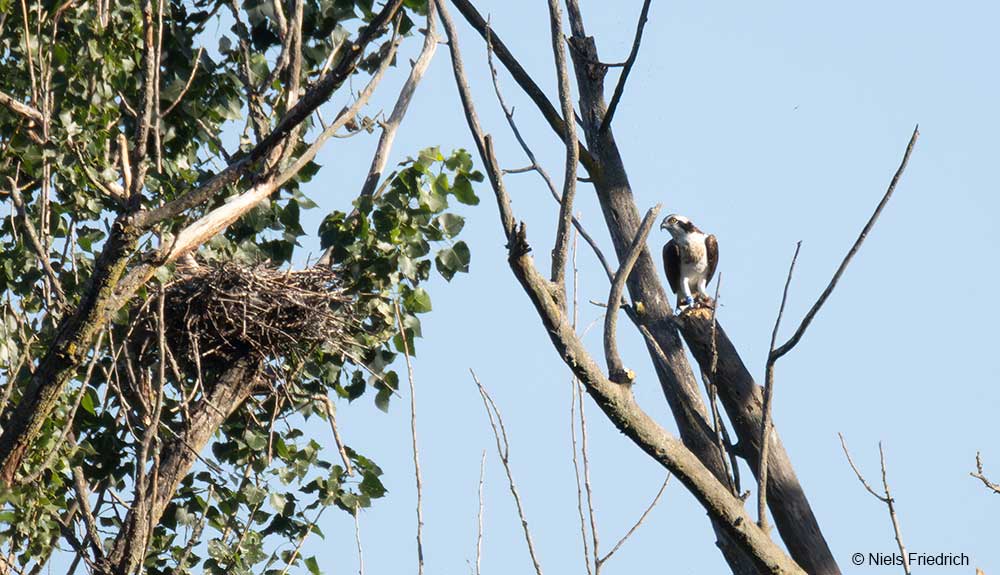On June 29, thanks to 41 observers stationed in the Trois-Lacs region with a few also in the Aar and Doubs river basins, we discovered that at least five Osprey are spending this summer in the Three-Lakes region. This second Osprey Morning of the season demonstrated once again how a simultaneous observation covering as many potential fishing sites as possible (26 in total) helps to better understand the real situation, especially at a time of year when many birders are off on holiday or up in the mountains.
The first Osprey was heard at 05:09 at Hagneck, Lake Bienne, where one was later seen (and identified as Arthur F12) at 06:58. Around the Fanel Nature Reserve on Lake Neuchâtel, there were a number of participants triangulating between the jetty of the Thielle, the ALA and Nos Oiseaux observation towers, and the jetty of the Chablais du Cudrefin. They saw their first Osprey (eating a fish) at 05:24, which was then lost from sight at 05:44. Between 06:20 – 07:36, either the same individual or another was observed, again eating a fish, while a second Osprey was spotted from 07:25 – 07:40. At 07:57 a blue-ringed male (likely Racine F29) was seen perched before making eight half-hearted fishing attempts from 08:38-08:44 while being mobbed by a Common Tern and a Black Crow. He was eventually lost from sight at 08:55, flying towards Le Landeron.
Back to Hagneck, the sudden arrival of Racine at 09:17 (who had previously already been seen visiting the other two males in the area) immediately triggered territorial defence behaviour from Arthur against the intruder. Regarding the other Osprey seen earlier in Fanel at the same time, it was probably an immature unringed female, which has been observed several times with Racine since June 4.
Meanwhile further south-west in the Grande Cariçaie, five other teams recorded two different Osprey: Olympe (F28) and an immature unringed female. Olympe was first seen in a display flight with a fish in his talons at 05:38. A similar behaviour was seen again at 08:28, when he brought the fish he was carrying to one of his nests, where an unringed female was then seen eating it nearby at 08:42. So two birds were definitely counted in that territory, just like during the last Osprey Morning on June 15. But the big question remained: was this female the same one seen at Fanel – at the same time as Racine – until around 07:40, and which may have joined Olympe an hour later? Or are there actually two different unringed females in the region, as we have been suspecting for quite some time already?
Fortunately there were three other teams spread around Lake Morat, and one of them spotted an Osprey (being chased by a Yellow-legged Gull) over Salavaux at 08:42. Definitely not Olympe or “his” immature unringed female, nor Arthur or Racine. A good possibility is that it was the unringed female which had left Fanel around 07:40. So the results of this second Osprey Morning seriously support our suspicions that at least two unringed females are discretely spending this summer in the Three-Lakes region. An impression further reinforced on June 30th, when Racine was seen perched next to an unringed female, in a place where one team had spent the entire morning of the 29th without seeing a single Osprey!
Big thanks go to all the team, including of course those not lucky enough to be at sites where Osprey were seen. Since we can never predict where one (or two) Osprey might turn up, and the species never seems to do the same thing from one day to another, it is crucial to cover as many observation spots as possible at the same time. It is also fundamental to start the watch at dawn, to increase the chance of seeing the birds catch or eat their first fish of the day – with the added benefits of escaping a heatwave (very intense on June 29th), and also to observe a multitude of other interesting species.

